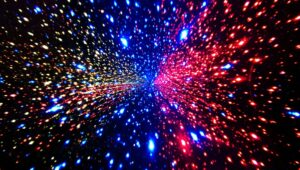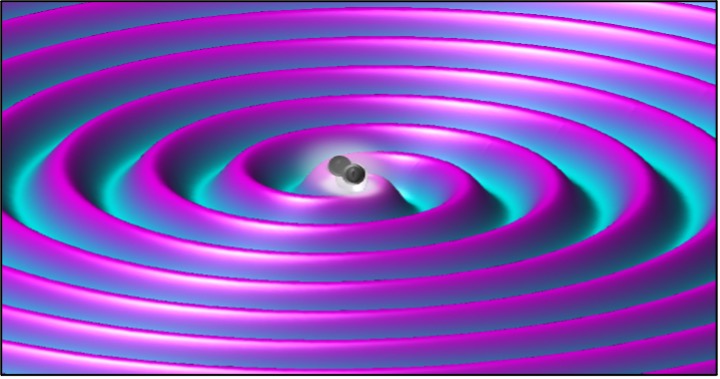
Figure 1: Simulated model of spacetime ripples as a result of colliding in spiral blackholes
Source: Wikimedia Commons
Introduction:
Gravitational wave observations enable us to study the formation and growth of massive black holes within their co-evolving host galaxies. They also provide insights into the structure of our galaxy, and help validate the theory of general relativity in extreme conditions. Spacetime is a four-dimensional reference frame, consisting of three dimensions in space and one dimension in time. As a part of the theory of general relativity, spacetime is thought to be curved by the presence of mass. The space time fabric is distorted like a rubber sheet upon which celestial bodies press down.

Figure 2: Graphic representation of “Spacetime”, the medium through which gravitational waves pass and cause detectable ripples
Source: Wikimedia Commons
Albert Einstein finalised his general theory of relativity in 1915, extending the special theory of relativity that he had developed ten years earlier in 1905. It was just the following year, 1916, that Einstein deduced that ripples through spacetime, produced by massive objects, could theoretically be detected. However, Einstein also believed that such waves would never be detected in practice because the effects produced would be so incredibly small.
If gravitational waves existed as Einstein predicted, and they were to be detected, the device observing them would have to cope with variations in the gravitational force that were a billion times weaker than the Earth’s surface gravity. According to Brian Clegg (2018), gravitational waves are weak compared to electromagnetic waves. In practice, as we shall see, a number of possibilities now exist for sources of gravitational waves that could reach this kind of precision, but many physicists at the time agreed with Einstein that these variations would be too difficult to detect.
Aside from gravitational waves, scientists can also derive information about the universe from electromagnetic radiation. This information is incomplete, however, as the Earth’s atmosphere blocks most of electromagnetic waves from reaching the surface. The various forms of electromagnetic radiation are detected from different vantage points. Visible light and radio waves get through to telescopes on the ground while detectors for UV and infrared work up high in the mountains. Mounting these telescopes in mountains is costlier (Science Learning hub, 2009)
Information carried by gravitational waves, however, allows us to observe space from a unique perspective. Bernard Schutz, a physicist at the University of Cardiff, UK, realized that gravitational waves could provide answers to significant events in the history of the universe (Castelvecchi, 2018). If detectors could measure ripples in space-time, emanating from interacting pairs of distant objects, scientists would have all the information needed to calculate how strong the signal was to start with and how far the waves must had travelled to reach Earth. Furthermore, Schutz has predicted that gravitational waves could be unambiguous markers of how quickly the Universe is expanding.
In September 14th, 2015, contrary to Einstein’s expectations, the Laser Interferometer Gravitational-wave Observatory (LIGO) became the first device to detect gravitational waves (CALTECH, 2016). The recognized source was a pair of colliding black holes. As the orbits of the two blackholes decay, bringing them closer and closer together, energy is lost and transmitted in the form of waves. The ultimate merger of the black holes produces a gravitational wave outburst which sends detectable ripples across spacetime. This sort of outburst generated the signal detected by LIGO (H. U. Nørgaard-Nielsen, 2018).
Since LIGO’s first detection, we’ve gained tremendous insight into the nature of the Cosmos. With the ability to detect gravitational waves, we can now detect events that would otherwise leave little to no observable light, like black hole collisions. Astronomers have been able to combine gravitational waves with more traditional ways of seeing the universe (Drake, 2015).
Laser Interferometer Gravitational-wave Observatory (LIGO) and Advanced LIGO:
The Laser Interferometer Gravitational-Wave Observatory (LIGO) was conceived by Rai Weiss of MIT and was designed between 1968 and 1972. His design called for 4km long laser paths in order to mitigate the effects of the extremely small distance in which gravitational waves cause a stretch in spacetime fabric. 4km is the longest straight path that can be built without having to tunnel through the Earth (Nergis Malalvala, 2018). With that scale spacetime will stretch by a small, but detectable length of about 10-18m. Construction on LIGO began in 1994 and completed in 1999. Today LIGO is comprised of two detectors, one in Louisiana and one in Washington state. The two US-based LIGO detectors are part of a global network of detectors that includes GEO600 and VIRGO.
LIGO Uses the Michelson Interferometer principle (Figure 2 below) to observe ripples. This is basically a system in which waves are superimposed, causing the phenomenon of interference to occur. A single laser is split and sent down two paths at right angles to each other. The two laser beams meet two suspended mirrors which then reflect back upon each other. When they recombine, they produce a pattern of interference. When ripples are detected, the laser travelling path changes, registering a new interference pattern. This is because gravitational waves are quadrupolar in nature, meaning that when they pass through a circular spacetime fabric, one axis is stretched while the other axis shrinks. The same principle applies to LIGO. When gravitational waves are detected, one arm is extended while the other one is shortened, changing the distance and/or time the laser beams take to reflect from the mirrors at the end of each arm.
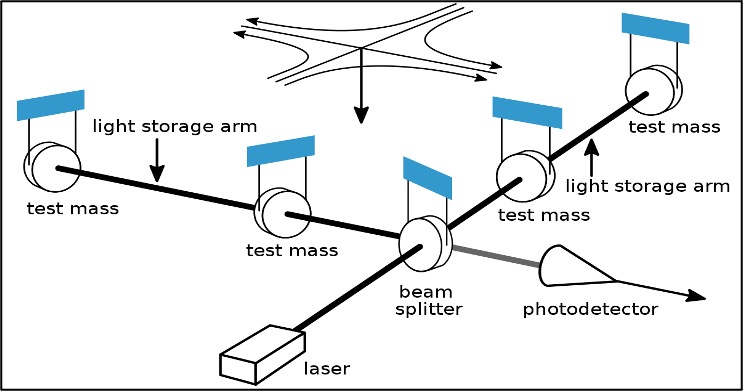
Figure 3: A schematic view of LIGO. The picture shows an interferometry mirror system. A laser is sent to the beam splitter, and the two resulting beams are sent to mirrors. The reflected beams are then combined by a photodetector, registering a pattern
Source: Wikimedia Commons
LIGO is built to ensure that only gravitational waves cause detections. That means isolating the detectors from any ambient vibrations or motion, which could alter the laser travel time and produce a signal. The mirrors are attached to both passive and active seismic isolation systems. The passive systems use springs and operate like shock absorbers on a car. The active systems consist of seismic detectors that measure vibrations and use small motors to cancel them out before they influence the mirrors. The mirrors are suspended from a series of four pendulums, adding another layer of passive isolation. A pendulum is a naturally good isolation system that prevents vibrations above its threshold natural frequency from reaching the mirror. Mirrors are housed inside enormous vacuum chambers so that atmospheric gases do not interfere with gravitational wave measurements (World Science University, 2018).
Advanced LIGO
The original LIGO reached peak sensitivity in 2007 when it could detect spacetime stretching on the order of 10-21m in the frequency range of 10Hz-10kHz. However, it did not detect anything during its operation. In 2008, the LIGO team began to design and build the next phase of the detector, called Advanced LIGO. This effort aims to achieve a significantly better sensitivity as well as a broader frequency range that it can search. To go from the initial LIGO to Advanced LIGO required three major upgrades: better seismic isolation to improve low-frequency sensitivity, better materials to eliminate thermal vibrations in the mirrors for improved intermediate frequency sensitivity, and increased laser power to improve high frequency sensitivity. Not all of the Advanced LIGO upgrades have been implemented yet, but the detectors began running at increased sensitivity in 2015. Full design sensitivity for Advanced LIGO will be achieved by 2021 (LIGO-MIT, 2016).
VIRGO Interferometer and Advanced VIRGO:
The VIRGO interferometer is located in Cascina, Italy and operates on the Michelson Interferometer principle that is used in LIGO. A beam-splitter divides a laser beam into two equal components, which are subsequently sent to the two interferometer arms. In each arm, a two-mirror Fabry-Perot resonant cavity extends the optical length from 3 kilometers to approximately 100 Kilometers. This is because of multiple reflections that occur within each cavity and amplify the tiny distance variation caused by a gravitational wave. (About Virgo, 2019)
Any variation caused by an alteration in the distance between the mirrors produces a very small shift in phase between the beams and, thus, a variation of the intensity of the light which is proportional to the wave’s amplitude (Sathyaprakash & Schutz, 2021). From 2016, VIRGO team started initiating major upgrades into the detector. This translated to advanced VIRGO. Two input mirrors are being added, improving the bounce back by one hundred times (Kraan, 2016). Further sensitivity has been incorporated by the addition of other new mirrors: a dihedron mirror, a power recycling mirror, a signal recycling mirror and an input mode cleaner mirror. The input cleaner mirror and dihedron mirror increase sensitivity further by recycling outgoing light into the cavities, and the mode cleaner device removes subtle air vibrations caused by laser beam which might interfere with the readings (Kraan, 2016).
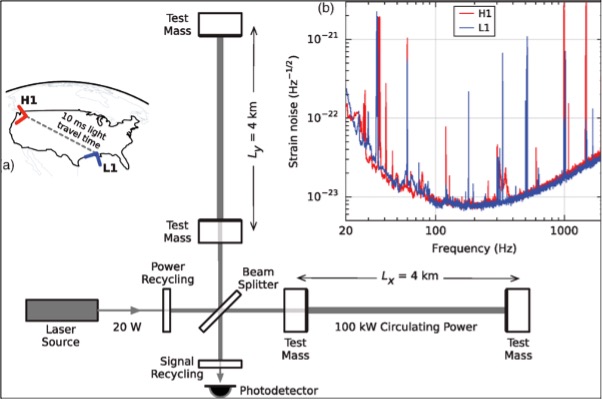
Figure 4: Optical layout of Advanced Virgo during the third observing run, O3 2019-2020. Strain noise denotes the vibrations generated by the devices components and other external factors that impede accurate recording of gravitational waves
Source: Wikimedia Commons
GEO 600 and Advanced GEO 600:
The GEO 600 model is different from Advanced LIGO and VIRGO as it doesn’t have arm cavities but employs the Fabry–Pérot interferometer (FPI) or etalon which is an optical cavity made from two parallel surfaces. It consists of two 600-meter long arms.
The laser beam passes twice, so that the effective optical arm length is 1200 m. The major optical components are located in an ultra-high vacuum system. The pressure is in the range of 10−8 mmillibars (University of Hannover, 2018). The main mirrors of GEO 600 are made of fused silica with a diameter of 18 cm and height of 10 cm (University of Hannover, 2018). The beam splitter is the only transmissive piece of optics and is made of special grade fused silica which has an absorption rate of less than 0.25 particles per minute/cm (Stefan et al., 2006)
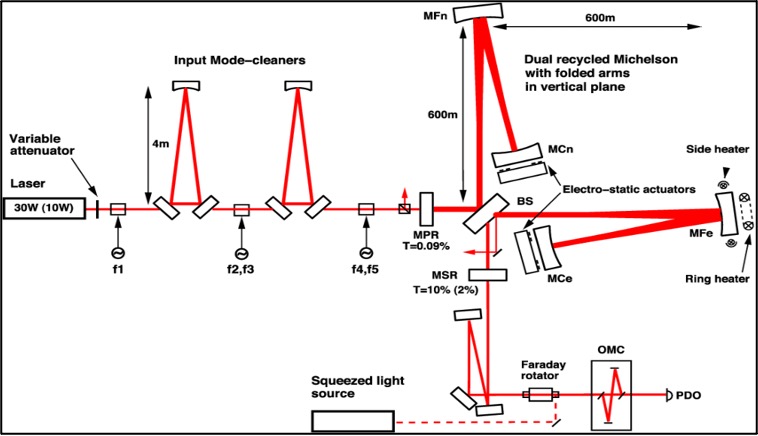
Figure 5: Simplified optical layout of the GEO 600 detector. GEO 600 is a dual (power and signal) recycled Michelson interferometer with single folded arms within 600 meter long beam tubes
Source: Wikimedia Commons
The advanced GEO 600 device incorporates suspension of mirrors using the triple pendulum suspension. The pendulums reduce seismic vibrations from affecting the mirrors while silica fused steel wires are used to support the secondary mirrors (Max Planck Gesellschaft, 2021). GEO 600’s main mirrors hang from this silica-fused suspension wire. Silica is used because it is prone to fewer mechanical losses leading to less external vibrations (Hild Stefan et al. 2006).
Another new feature in the Advanced GEO 600 is the incorporation of electrostatic drives. Actuators are needed to keep the mirrors in aligned positions. The secondary mirrors of GEO600 have magnets glued to them for this purpose. Since gluing magnets to mirrors will increase mechanical friction losses, the main mirrors of GEO600 now use electrostatic drives (ESDs) instead of being joined to magnets (IOP science, 2021). Mechanical friction losses are generated as a result of friction between the magnet and mirror. The vibration generated, in tur, interrupts accurate recordings of gravitational waves. The ESDs are comb-like structures of electrodes at the back side of the mirror. If a voltage is applied to the electrodes, they produce an inhomogeneous electric field. The mirror will feel a force as it is permeated by the field. This force hypothetically repels the laser particles (quanta) from being absorbed by the mirror and minimizes absorption of these particles (IOP science, 2021).
The advanced GEO 600 also has a thermal mirror actuation system: A system of heaters sitting at the far east mirror. When heated, a thermal gradient will appear in the mirror, and the radius of curvature of the mirror changes due to thermal expansion. The heaters allow thermal tuning of the mirror’s radius of curvature. GEO600 pioneered the use of thermal compensation systems for tuning the signal. Another system compensates the thermal lens inside the beam splitter (Max Planck Gesellschaft, 2021).
The advanced GEO 600 has embraced signal recycling. This has been done by placing an additional mirror at the output of the interferometer. It forms a resonant cavity together with the end mirrors and thus increases the strength of an incoming signal (IOP science, 2021).
The advanced GEO600 has incorporated an Output Mode Cleaner (OMC). Due to microscopic defects in the initial GEO 600’s mirrors, light generated concealed the signal GEO600 was looking for and therefore it had had to be removed. OMC is an additional cavity at the output of the interferometer in front of the photodiode. Its purpose is to filter out light that does not potentially carry a gravitational wave signal. The output mode cleaner that was implemented is an arrangement of mirrors, a so-called optical resonator, which only lets light pass through which carries the gravitational-wave signal. The exact design choice of such a resonator and the best system to control the resonators’ alignment is an active field of research to which GEO 600 has been making important contributions (Max Planck Gesellschaft, 2020).
The quantum nature of light itself impedes the precision of recorded Gravitational wave signals. This is because light exists in smaller particles called quanta. These quanta exist in a non-defined manner and accelerating them to hit the mirror generates a lot of vibration (Max Planck Gesellschaft, 2020). GEO 600 was the first gravitational wave detector to apply squeezed light injection to reduce this quantum noise, and it holds a world record for the duration and strength of squeezed light used. The squeezed light source was developed and built at the Albert Einstein Institute, and currently the optimal application of squeezed light injection is a topic of ongoing research at GEO 600. Topics of this research include:
- the development of an automatic alignment system for squeezed light,
- the development of a new control signal for squeezing angle detection, and
- automated locking of the squeezed light source.
With all these techniques combined, the first long-term application of squeezed light at a GW detector has been achieved. The use of squeezing can improve the sensitivity of GEO600 above 700 Hz by a factor of 1.5 (LIGO Scientific Collaboration, 2016).
TAMA 300 (ceased operations):
TAMA300 is no longer participating in observations, but is still active, acting as a testbed for new technologies to improve other detectors (National Astronomical Observatory of Japan, 2020). One example of testing involves research to eliminate quantum noise in detection machines. Since the detector is no longer in operation, no improvements have been made to it. The National Astronomical Observatory of Japan is currently dedicating all resources in construction of the Kamioka Gravitational wave detector which is expected to be complete by 2021.
TAMA300 is located at the Mitaka Campus of the National Observatory of Japan. It is a project led by the institute of the Institute for Cosmic Ray Research (I.C.R.R.). It has 300m optical arms, and is officially known as the 300m Laser Interferometer Gravitational Wave Antenna (FPMI). It also operates with the farby-perot Michelson interferometer, just like GEO 600.
What the future holds:
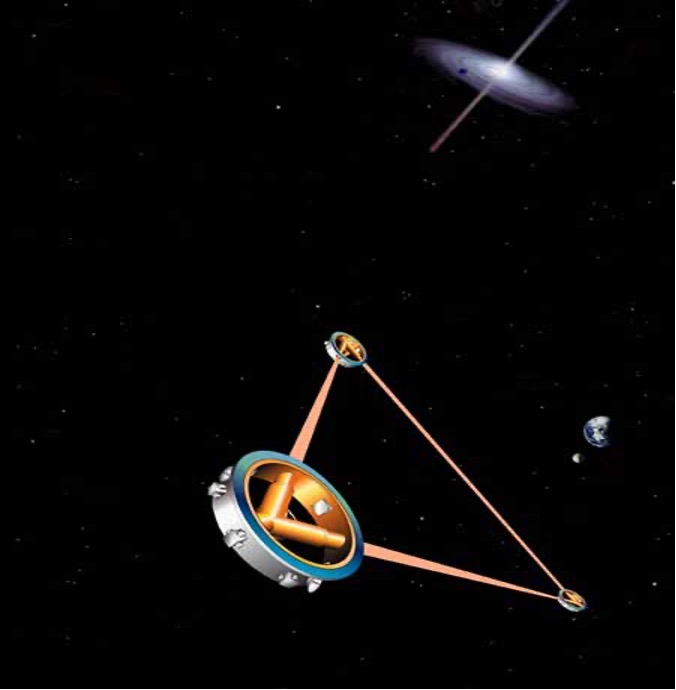
Figure 6: The LISA spacecraft will be placed in orbits that form a triangular formation with center 20° behind the Earth and a side length of 5 million km. (The figure showing the formation is not to scale)
Source: Wikimedia Commons
Laser Interferometer Space Antenna (LISA)
Established in 2010, LISA is a joint ESA-NASA mission that will enable observation of low gravitational wave signals which cannot be detected by Earth observatories. It involves having three spacecrafts oriented approximately 2.5 million kilometers apart in an equilateral triangle formation. Its major mission is to detect gravitational waves within frequencies of 10-4 Hz to 10-1 Hz (World science Festival, 2018; Max Planck institute, 2014). The project is designed to measure the wavelength, direction, and polarisation of the gravitational waves simultaneously (Nergis Mavalvala, 2018). If polarisation is known, orbit inclination can be determined, and this will allow the mass of binary systems to be inferred. Binary systems are pair of massive objects rotating towards each other. We have three classes of binary systems: the binary neutron star, binary black hole and neutron star-blackhole binary (CALTECH, 2016).
Observation of signals involving massive black holes will help verify the theoretical predictions of general relativity and blackhole theory with unprecedented accuracy. The ESA-NASA collaboration is highly optimistic that LISA will discover a diverse array of astrophysical sources (“Why LISA? gravitational waves,” n.d.). These sources range from tens to hundreds of inward spiralling and merging blackholes and more than ten thousand close, compact binaries in the galaxy. The instrument will view more than one thousand sources within a month’s operation time (ESA). Additional parameters such as mass, spin and luminosity distance will be measured with high precision.
The project is being run in two phases: the LISA pathfinder and E-LISA.

Figure 7: An image of the LISA pathfinder showing the external coating with gold-platinum alloy to protect its sensitive components against extreme space conditions like stray radiation
Source: Wikimedia Commons
A. LISA pathfinder
LISA pathfinder was launched on December 3rd 2015 and decommissioned in 2017. Its mission was to prove that it could shield a payload of two metal cubes from internal and external forces. Each free-floating cube was 44mm per side and made of a gold-platinum alloy that provided protection from the adverse effects of interplanetary space. The distance within the cubes was monitored using advanced accurate laser-based techniques which made it possible to detect minute changes caused by passing gravitational waves. The spacecraft’s position in space was known to an accuracy between 10-9 m and 10-12 meters (LISA pathfinder, 2015).
The technology of free-floating cubes inside the spacecraft could not be tested on earth due to earth’s gravity – the cubes would simply be pulled back to the ground. In space, however, masses float freely for a long time with the help of the gold-platinum shield. The spacecraft manoeuvres around them, sensing their motion and adjusting its own to compensate. LISA pathfinder’s precise inter-test-mass tracking by optical interferometry allowed scientists to determine the relative acceleration of the two test masses; situated about 38 cm apart in single aircraft (LISA Technology Package, 2021).
In summary, LISA pathfinder verified:
- Drag free attitude control of a craft with two masses
- Feasibility of laser interferometry in the desired frequency band
- Reliability and longevity of various components like capacitive sensors, micro thrusters, lasers and optics.
B. E-LISA (Yet to be commissioned)
For the follow-up mission, E-LISA is now capable of detecting environmental factors that will influence the measurements the interferometer takes. These environmental influences include stray electromagnetic fields, solar winds, and temperature gradients, the latter of which could be caused by the Sun heating the spacecraft unevenly, or even by warm instrumentation inside the spacecraft itself. LISA Pathfinder flew with an extensive instrument package which can measure temperature and magnetic fields at the test masses and at the optical bench. The spacecraft was even equipped to stimulate the system artificially: it carried heating elements which can warm the spacecraft’s structure unevenly, causing the optical bench to distort and enabling scientists to see how the measurements change with varying temperatures.
Whether or not E-LISA will use Michelson Interferometry and specific component machinery is yet to be determined. E-LISA will ferry the same instruments as LISA pathfinder and it is a project that will be carried out in 2034 (World Science Festival, 2018). Information from LISA sources will provide unique insight into extraordinary astrophysical objects.
Gravitational wave observations will enable studies of the formation and growth of massive black holes and their co-evolving host galaxies, stellar populations, the dynamics of galactic nuclei, compact stars, the structure of our galaxy, and general relativity in extreme conditions. Information from LISA will provide unique insight into extraordinary astrophysical objects. Combined with electromagnetic observations, these insights will advance our broader scientific understanding of space.
References
Lambourne, R. J. A. (2010). Relativity, gravitation and cosmology (pp. 226–241). Cambridge University Press.
Aufmuth, P., & Mors, K. (2021). GEO 600 — Data. Www.geo600.Uni-Hannover.de. www.geo600.uni-hannover.de/geo600/project/geodata.html
CALTECH. (2016). Gravitational Waves Detected 100 Years After Einstein’s Prediction. LIGO Lab | Caltech. www.ligo.caltech.edu/news/ligo20160211.
Castelvecchi, D. (2018). How gravitational waves could solve some of the Universe’s deepest mysteries. Nature, 556(7700), 164–168. www.nature.com/articles/d41586-018-04157-6
Clegg, B. (2018). Read Gravitational Waves Online by Brian Clegg | Books. In www.scribd.com. Omnibus Business Centre, 2018. www.scribd.com/read/385694327/Gravitational-Waves-How-Einstein-s-spacetime-ripples-reveal-the-secrets-of-the-universe
Drake, N. (2019). National Geographic: Stories of Animals, Nature, and Culture. Nationalgeographic.com; National Geographic. www.nationalgeographic.com/science/article/new-gravitational-waves-neutron-stars-ligo-space-science
ESA. (2018). ESA Science & Technology – LISA Pathfinder. sci.esa.int/web/lisa-pathfinder
Drake, N., & Greshko, M. (2017, October 16). What Are Gravitational Waves, and Why Do They Matter? Science; National Geographic. www.nationalgeographic.com/science/article/what-are-gravitational-waves-ligo-astronomy-science
- U. Nørgaard – Nielsen. (2018, October 30). Confirmation of the detection of B-modes in the Planck polarization maps. Astrobites. astrobites.org/2018/10/30/glimpsing-the-fingerprints-of-gravitational-waves-in-the-early-universe/
Hensley, K. (2019). Can We Detect Gravitational Waves from Core-Collapse Supernovae? ASS NOVA.aasnova.org/2019/07/05/can-we-detect-gravitational-waves-from-core-collapse-supernovae/.
LISA. (2017). LPF Mission Journal | Lisamission.org. Www.lisamission.org. https://www.lisamission.org/articles/lisa-pathfinder/lpf-technology/ltp-lisa-technology-package
Max-Planck-Gesellschaft. (2020). Advanced Technologies GEO 600. Www.geo600.org; www.geo600.org/23441/advanced-technologies
MIT. (2016). Advanced LIGO. Mit.edu. www.advancedligo.mit.edu/overview.html
NAOJ. (2020). TAMA300 Blazes Trail for Improved Gravitational Wave Astronomy. National Astronomical Observatory of Japan. https://www.nao.ac.jp/en/news/science/2020/20200428-gwsp.html
News, W. (2011). LISA Gravity Waves | Gravitational Wave | Black Hole. Scribd; University Of Birmingham. www.scribd.com/document/64945646/LISA-Gravity-Waves?/. Accessed on 21/02/2021
Sathyaprakash, B. S., & Schutz, B. F. (2009). Physics, Astrophysics and Cosmology with Gravitational Waves. Living Reviews in Relativity, 12(1), 29-49 https://www.ncbi.nlm.nih.gov/pmc/articles/PMC5255530/
Science Learning Hub. (2021). Light and telescopes. ; www.sciencelearn.org.nz/resources/1625-light-and-telescopes
Related Posts
When Breaking the Ice Isn’t So Simple: The Phenomenon of Flexible Ice Crystals
Figure: Icicles like these, which have formed on a house...
Read MoreSpeed of Light Reduced Using Nanoantennas
Figure 1: The speed of light is extremely fast–186,00 miles...
Read MoreNuclear Fusion Startup May Hold the Key for Long-Term Nuclear Fusion
Figure 1: The image above shows the steps for inertial...
Read MoreFrankline Misango Oyolo


